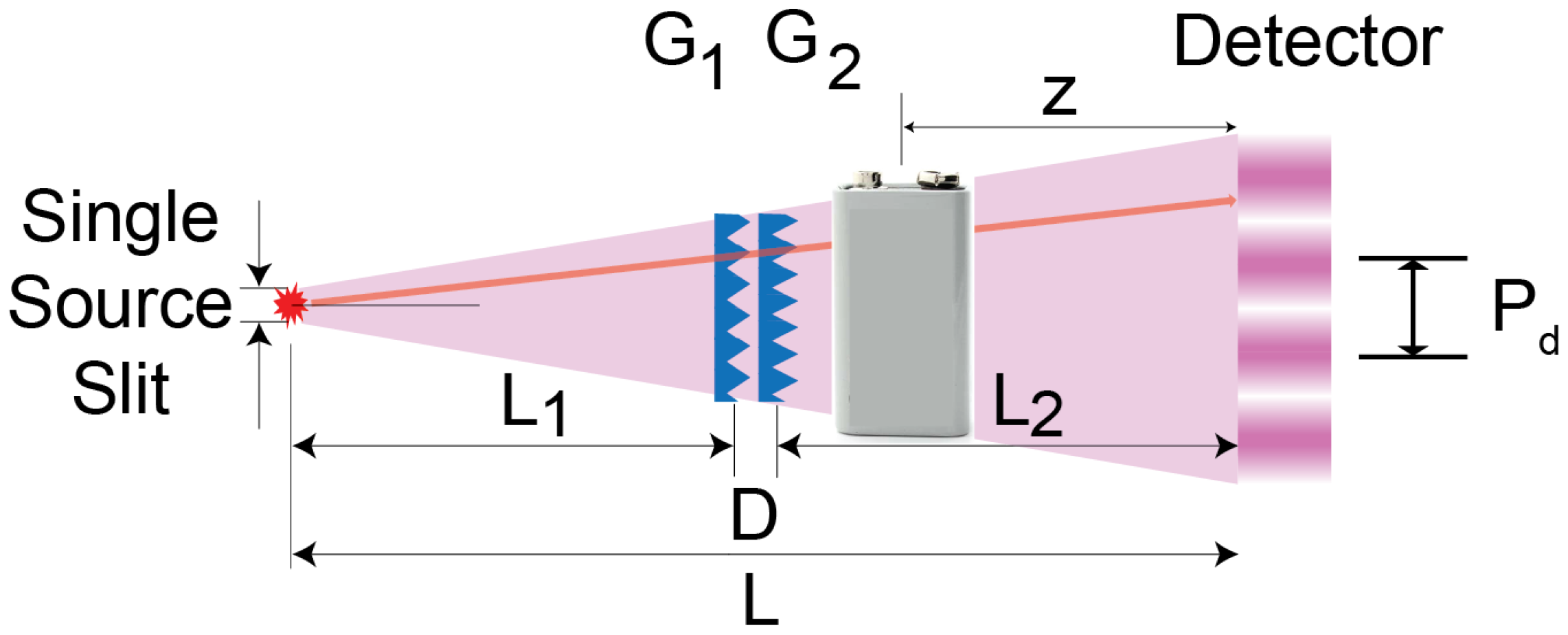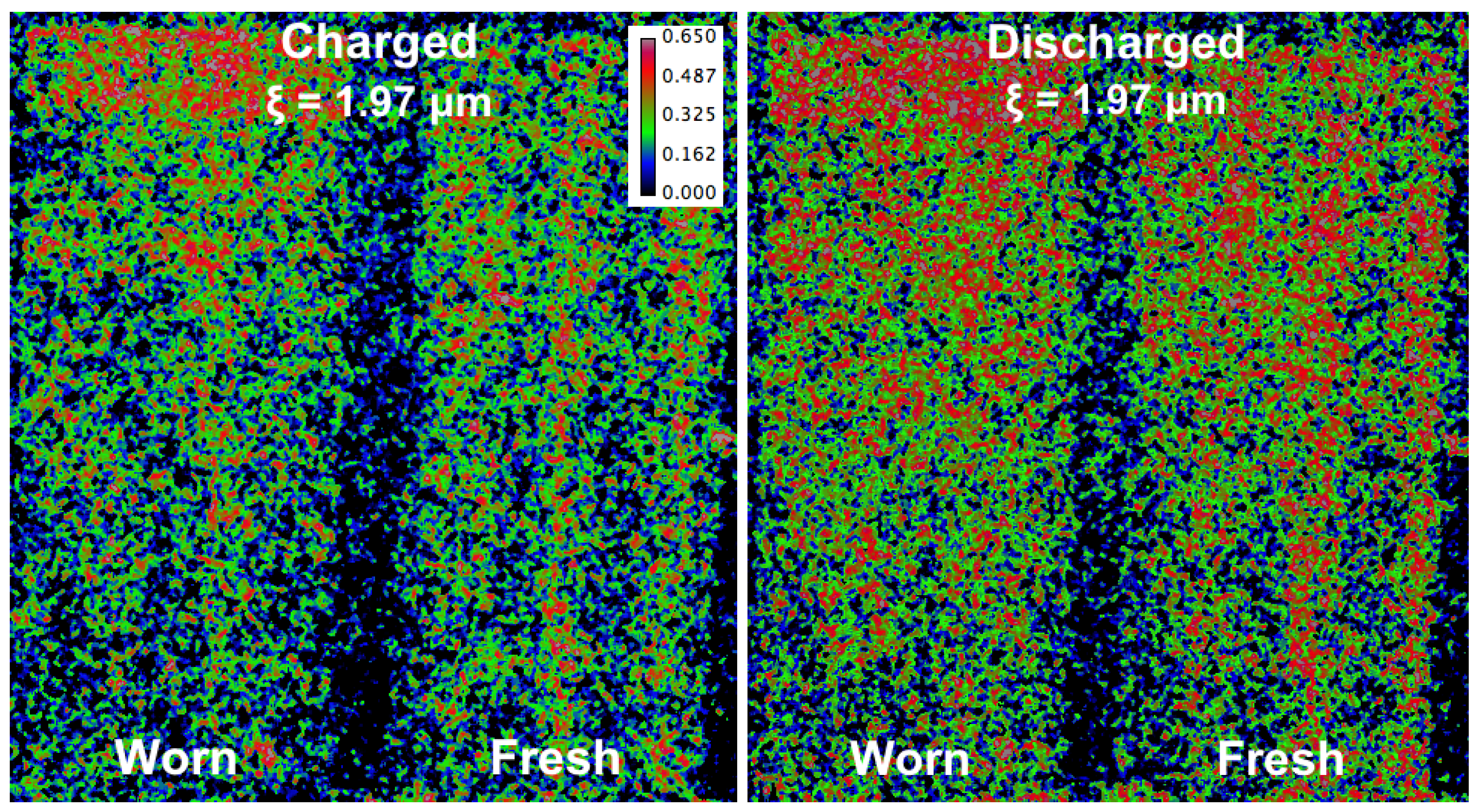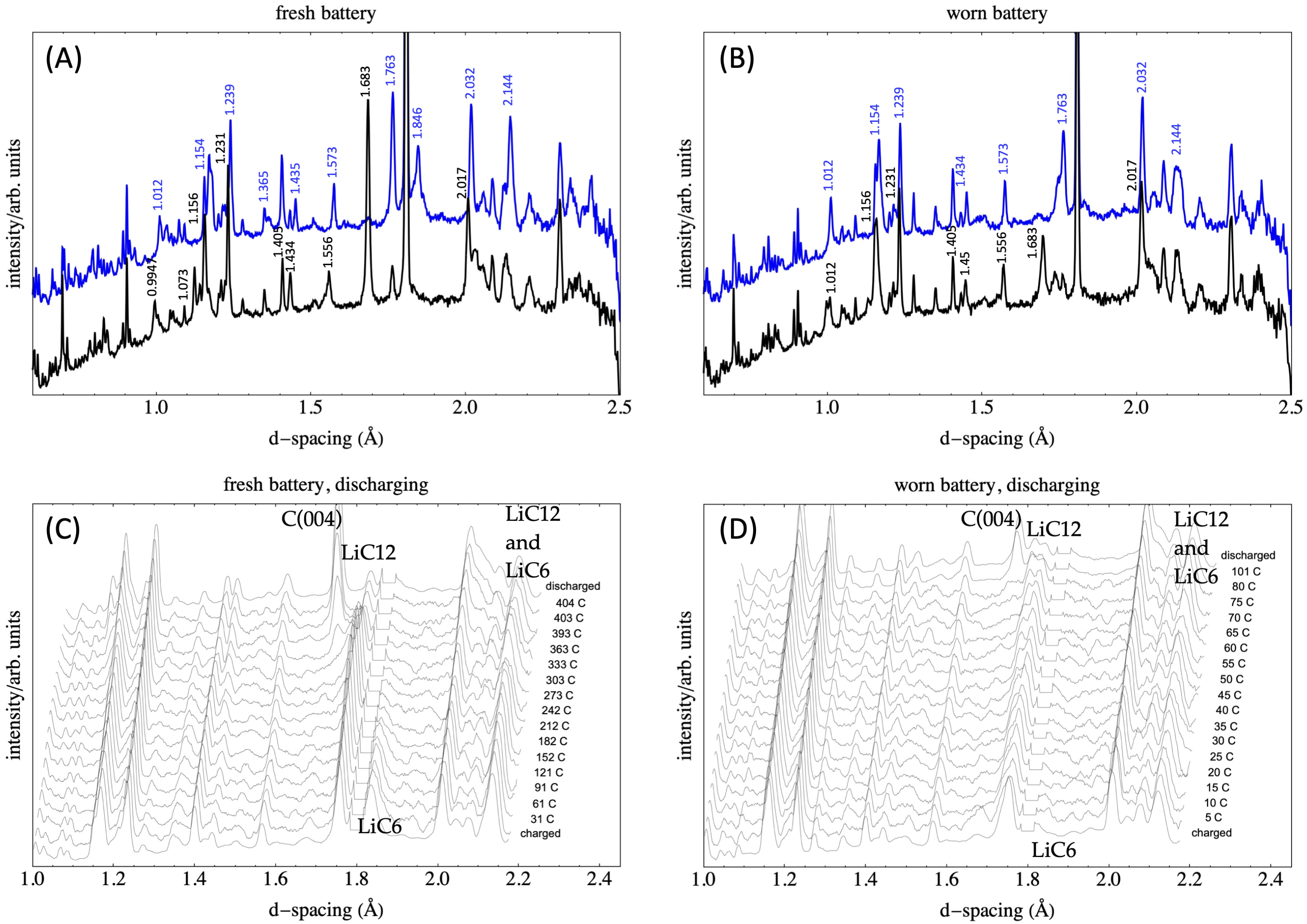Intact, Commercial Lithium-Polymer Batteries: Spatially Resolved Grating-Based Interferometry Imaging, Bragg Edge Imaging, and Neutron Diffraction
Abstract
:1. Introduction
2. Materials and Methods
2.1. Batteries
2.2. Imaging Background
2.3. Neutron Far-Field Interferometry Imaging at NIST
2.4. Neutron Talbot-Lau Grating Interferometry at HZB
2.5. Neutron Bragg Edge Imaging at HZB
2.6. Neutron Diffraction at SNS VULCAN
3. Results and Discussion
3.1. Far-Field Neutron Imaging at NIST
3.2. Neutron Talbot-Lau Interferometry at HZB
3.3. Neutron Bragg Edge Imaging at HZB
3.4. Neutron Diffraction Analysis
4. Conclusions
Author Contributions
Funding
Data Availability Statement
Conflicts of Interest
References
- Liu, K.; Zhuo, D.; Lee, H.W.; Liu, W.; Lin, D.; Lu, Y.; Cui, Y. Extending the Life of Lithium-Based Rechargeable Batteries by Reaction of Lithium Dendrites with a Novel Silica Nanoparticle Sandwiched Separator. Adv. Mater. 2017, 29, 1603987. [Google Scholar] [CrossRef] [PubMed]
- Chen, C.Y.; Sawamura, A.; Tsuda, T.; Uchida, S.; Ishikawa, M.; Kuwabata, S. Visualization of Si Anode Reactions in Coin-Type Cells via Operando Scanning Electron Microscopy. ACS Appl. Mater. Interfaces 2017, 9, 35511–35515. [Google Scholar] [CrossRef] [PubMed]
- Li, Y.; Wang, S.; Lee, P.K.; He, J.; Yu, D.Y. Crack-resistant polyimide coating for high-capacity battery anodes. J. Power Sources 2017, 366, 226–232. [Google Scholar] [CrossRef]
- Liu, D.; Shadike, Z.; Lin, R.; Qian, K.; Li, H.; Li, K.; Wang, S.; Yu, Q.; Liu, M.; Ganapathy, S.; et al. Review of recent development of in situ/operando characterization techniques for lithium battery research. Adv. Mater. 2019, 31, 1806620. [Google Scholar] [CrossRef] [PubMed]
- Atkins, D.; Capria, E.; Edström, K.; Famprikis, T.; Grimaud, A.; Jacquet, Q.; Johnson, M.; Matic, A.; Norby, P.; Reichert, H.; et al. Accelerating Battery Characterization Using Neutron and Synchrotron Techniques: Toward a Multi-Modal and Multi-Scale Standardized Experimental Workflow. Adv. Energy Mater. 2021. [Google Scholar] [CrossRef]
- Wu, L.; Zhang, Y.; Yang, X.; Santodonato, L.; Bilheux, H.; Zhang, J. Neutron imaging of lithium concentration in LiNi0.33Mn0.33Co0.33O2 cathode. J. Neutron Res. 2020, 22, 43–48. [Google Scholar] [CrossRef]
- Singh, H.; Hayat, M.; Huang, S.; Sui, Y.; Cao, P. An In situ neutron diffraction study of phase formation during Ti-Si3N4 powder sintering. Adv. Powder Mater. 2021. [Google Scholar] [CrossRef]
- Vitoux, L.; Reichardt, M.; Sallard, S.; Novák, P.; Sheptyakov, D.; Villevieille, C. A Cylindrical Cell for Operando Neutron Diffraction of Li-Ion Battery Electrode Materials. Front. Energy Res. 2018, 6, 76. [Google Scholar] [CrossRef]
- Liang, G.; Didier, C.; Guo, Z.; Pang, W.K.; Peterson, V.K. Understanding Rechargeable Battery Function Using In Operando Neutron Powder Diffraction. Adv. Mater. 2020, 32, e1904528. [Google Scholar] [CrossRef]
- Zhao, E.; Zhang, Z.G.; Li, X.; He, L.; Yu, X.; Li, H.; Wang, F. Neutron-based characterization techniques for lithium-ion battery research. Chin. Phys. B 2020, 29, 018201. [Google Scholar] [CrossRef]
- Wu, X.; Song, B.; Chien, P.H.; Everett, S.M.; Zhao, K.; Liu, J.; Du, Z. Structural Evolution and Transition Dynamics in Lithium Ion Battery under Fast Charging: An Operando Neutron Diffraction Investigation. Adv. Sci. 2021, 8, 2102318. [Google Scholar] [CrossRef] [PubMed]
- Sørensen, D.R.; Heere, M.; Zhu, J.; Darma, M.S.D.; Zimnik, S.M.; Mühlbauer, M.J.; Mereacre, L.; Baran, V.; Senyshyn, A.; Knapp, M.; et al. Fatigue in High-Energy Commercial Li Batteries while Cycling at Standard Conditions: An In Situ Neutron Powder Diffraction Study. ACS Appl. Energy Mater. 2020, 3, 6611–6622. [Google Scholar] [CrossRef]
- Wang, X.L.; An, K.; Cai, L.; Feng, Z.; Nagler, S.E.; Daniel, C.; Rhodes, K.J.; Stoica, A.D.; Skorpenske, H.D.; Liang, C.; et al. Visualizing the chemistry and structure dynamics in lithium-ion batteries by in-situ neutron diffraction. Sci. Rep. 2012, 2, 1–7. [Google Scholar] [CrossRef] [PubMed]
- Cai, L.; An, K.; Feng, Z.; Liang, C.; Harris, S.J. In-situ observation of inhomogeneous degradation in large format Li-ion cells by neutron diffraction. J. Power Sources 2013, 236, 163–168. [Google Scholar] [CrossRef]
- Liu, H.; Liu, H.; Lapidus, S.H.; Meng, Y.S.; Chupas, P.J.; Chapman, K.W. Sensitivity and limitations of structures from X-ray and neutron-based diffraction analyses of transition metal oxide lithium-battery electrodes. J. Electrochem. Soc. 2017, 164, A1802. [Google Scholar] [CrossRef]
- Yang, S.; Fan, Q.; Shi, Z.; Liu, L.; Liu, J.; Ke, X.; Liu, J.; Hong, C.; Yang, Y.; Guo, Z. Superior stability secured by a four-phase cathode electrolyte interface on a Ni-rich cathode for lithium ion batteries. ACS Appl. Mater. Interfaces 2019, 11, 36742–36750. [Google Scholar] [CrossRef]
- Fan, Q.; Yang, S.; Liu, J.; Liu, H.; Lin, K.; Liu, R.; Hong, C.; Liu, L.; Chen, Y.; An, K.; et al. Mixed-conducting interlayer boosting the electrochemical performance of Ni-rich layered oxide cathode materials for lithium ion batteries. J. Power Sources 2019, 421, 91–99. [Google Scholar] [CrossRef]
- Bobrikov, I.A.; Samoylova, N.Y.; Sumnikov, S.V.; Ivanshina, O.Y.; Vasin, R.N.; Beskrovnyi, A.I.; Balagurov, A.M. In-situ time-of-flight neutron diffraction study of the structure evolution of electrode materials in a commercial battery with LiNi0.8Co0.15Al0.05O2 cathode. J. Power Sources 2017, 372, 74–81. [Google Scholar] [CrossRef]
- Gummow, R.J.; Sharma, N.; Peterson, V.K.; He, Y. Synthesis, structure, and electrochemical performance of magnesium-substituted lithium manganese orthosilicate cathode materials for lithium-ion batteries. J. Power Sources 2012, 197, 231–237. [Google Scholar] [CrossRef] [Green Version]
- Hofmann, M.; Gilles, R.; Gao, Y.; Rijssenbeek, J.T.; Muehlbauer, M.J. Spatially resolved phase analysis in sodium metal halide batteries: Neutron diffraction and tomography. J. Electrochem. Soc. 2012, 159, A1827–A1833. [Google Scholar] [CrossRef]
- Senyshyn, A.; Muehlbauer, M.J.; Dolotko, O.; Hofmann, M.; Pirling, T.; Ehrenberg, H. Spatially resolved in operando neutron scattering studies on Li-ion batteries. J. Power Sources 2014, 245, 678–683. [Google Scholar] [CrossRef]
- Kino, K.; Yonemura, M.; Ishikawa, Y.; Kamiyama, T. Two-dimensional imaging of charge/discharge by Bragg edge analysis of electrode materials for pulsed neutron-beam transmission spectra of a Li-ion battery. Solid State Ionics 2016, 288, 257–261. [Google Scholar] [CrossRef]
- Kamiyama, T.; Narita, Y.; Sato, H.; Ohnuma, M.; Kiyanagi, Y. Structural change of carbon anode in a lithium-ion battery product associated with charging process observed by neutron transmission Bragg-edge imaging. Phys. Procedia 2017, 88, 27–33. [Google Scholar] [CrossRef]
- Ziesche, R.F.; Tremsin, A.S.; Huang, C.; Tan, C.; Grant, P.S.; Storm, M.; Brett, D.J.; Shearing, P.R.; Kockelmann, W. 4D Bragg Edge Tomography of Directional Ice Templated Graphite Electrodes. J. Imaging 2020, 6, 136. [Google Scholar] [CrossRef] [PubMed]
- Butler, L.G.; Schillinger, B.; Ham, K.; Dobbins, T.A.; Liu, P.; Vajo, J.J. Neutron imaging of a commercial Li-ion battery during discharge: Application of monochromatic imaging and polychromatic dynamic tomography. Nucl. Instrum. Methods Phys. Res. Sect. A 2011, 651, 320–328. [Google Scholar] [CrossRef]
- Campillo-Robles, J.M.; Goonetilleke, D.; Soler, D.; Sharma, N.; Martín Rodríguez, D.; Bücherl, T.; Makowska, M.; Türkilmaz, P.; Karahan, V. Monitoring lead-acid battery function using operando neutron radiography. J. Power Sources 2019, 438, 226976. [Google Scholar] [CrossRef]
- Sun, F.; Markötter, H.; Manke, I.; Hilger, A.; Alrwashdeh, S.S.; Kardjilov, N.; Banhart, J. Complementary X-ray and neutron radiography study of the initial lithiation process in lithium-ion batteries containing silicon electrodes. Appl. Surf. Sci. 2017, 399, 359–366. [Google Scholar] [CrossRef] [Green Version]
- Siegel, J.B.; Lin, X.; Stefanopoulou, A.G.; Hussey, D.S.; Jacobson, D.L.; Gorsich, D. Neutron Imaging of Lithium Concentration in LFP Pouch Cell Battery. J. Electrochem. Soc. 2011, 158, A523–A529. [Google Scholar] [CrossRef]
- Garlea, E.; King, M.O.; Galloway, E.C.; Boyd, T.L.; Smyrl, N.R.; Bilheux, H.Z.; Santodonato, L.J.; Morrell, J.S.; Leckey, J.H. Identification of lithium hydride and its hydrolysis products with neutron imaging. J. Nucl. Mater. 2017, 485, 147–153. [Google Scholar] [CrossRef] [Green Version]
- Nie, Z.; Ong, S.; Hussey, D.S.; LaManna, J.M.; Jacobson, D.L.; Koenig, G.M. Probing transport limitations in thick sintered battery electrodes with neutron imaging. Mol. Syst. Des. Eng. 2020, 5, 245–256. [Google Scholar] [CrossRef]
- Gelb, J.; Finegan, D.P.; Brett, D.J.; Shearing, P.R. Multi-scale 3D investigations of a commercial 18,650 Li-ion battery with correlative electron- and X-ray microscopy. J. Power Sources 2017, 357, 77–86. [Google Scholar] [CrossRef] [Green Version]
- Ziesche, R.F.; Arlt, T.; Finegan, D.P.; Heenan, T.M.; Tengattini, A.; Baum, D.; Kardjilov, N.; Markötter, H.; Manke, I.; Kockelmann, W.; et al. 4D imaging of lithium-batteries using correlative neutron and X-ray tomography with a virtual unrolling technique. Nat. Commun. 2020, 11, 1–11. [Google Scholar] [CrossRef] [PubMed] [Green Version]
- Pfeiffer, F.; Grunzweig, C.; Bunk, O.; Frei, G.; Lehmann, E.; David, C. Neutron phase imaging and tomography. Phys. Rev. Lett. 2006, 96, 215505. [Google Scholar] [CrossRef] [PubMed] [Green Version]
- Miao, H.; Panna, A.; Gomella, A.A.; Bennett, E.E.; Znati, S.; Chen, L.; Wen, H. A universal moire effect and application in X-ray phase-contrast imaging. Nat. Phys. 2016, 12, 830–834. [Google Scholar] [CrossRef] [Green Version]
- Pushin, D.A.; Sarenac, D.; Hussey, D.S.; Miao, H.; Arif, M.; Cory, D.G.; Huber, M.G.; Jacobson, D.L.; LaManna, J.M.; Parker, J.D.; et al. Far-field interference of a neutron white beam and the applications to noninvasive phase contrast imaging. Phys. Rev. A 2017, 95, 043637. [Google Scholar] [CrossRef] [Green Version]
- Marathe, S.; Assoufid, L.; Xiao, X.; Ham, K.; Johnson, W.W.; Butler, L.G. Improved algorithm for processing grating-based phase contrast interferometry image sets. Rev. Sci. Instrum. 2014, 85, 013704. [Google Scholar] [CrossRef]
- Lee, S.; Oh, O.; Kim, Y.; Kim, D.; Hussey, D.S.; Wang, G.; Lee, S.W. Deep learning for high-resolution and high-sensitivity interferometric phase contrast imaging. Sci. Rep. 2020, 10, 1–12. [Google Scholar] [CrossRef]
- Wen, H.; Bennett, E.E.; Hegedus, M.M.; Rapacchi, S. Fourier X-ray scattering radiography yields bone structural information. Radiology 2009, 251, 910–918. [Google Scholar] [CrossRef] [Green Version]
- Grizolli, W.; Shi, W.; Assoufid, L.; Butler, L.G. wavepy—Python package for X-ray grating interferometry with applications in imaging and wavefront characterization. AIP Conf. Proc. 2018; in press. [Google Scholar]
- Kardjilov, N.; Hilger, A.; Manke, I.; Griesche, A.; Banhart, J. Imaging with Cold Neutrons at the CONRAD-2 Facility. Phys. Procedia 2015, 69, 60–66. [Google Scholar] [CrossRef] [Green Version]
- Kardjilov, N.; Hilger, A.; Manke, I.; Woracek, R.; Banhart, J. CONRAD-2: The new neutron imaging instrument at the Helmholtz-Zentrum Berlin. J. Appl. Crystallogr. 2016, 49, 195–202. [Google Scholar] [CrossRef]
- Kino, K.; Yonemura, M.; Kiyanagi, Y.; Ishikawa, Y.; Parker, J.D.; Tanimori, T.; Kamiyama, T. First Imaging Experiment of a Lithium Ion Battery by a Pulsed Neutron Beam at J-PARC/MLF/BL09. Phys. Procedia 2015, 69, 612–618. [Google Scholar] [CrossRef] [Green Version]






| Expt. | Facility | Capacity/mAh | Summary of Results |
|---|---|---|---|
| Far-Field | NIST | 43, 90 | wear: 43 mAh may be optimum size for battery capacity and imaging |
| Talbot-Lau | HZB | 15 | wear: 15 mAh is too small |
| Bragg-Edge | HZB | 15 | wear: 15 mAh is too small |
| Diffraction | SNS | 300 | chemistry: 300 mAh may be optimum size |
Publisher’s Note: MDPI stays neutral with regard to jurisdictional claims in published maps and institutional affiliations. |
© 2022 by the authors. Licensee MDPI, Basel, Switzerland. This article is an open access article distributed under the terms and conditions of the Creative Commons Attribution (CC BY) license (https://creativecommons.org/licenses/by/4.0/).
Share and Cite
Brooks, A.J.; Hussey, D.S.; Ham, K.; Jacobson, D.L.; Manke, I.; Kardjilov, N.; Butler, L.G. Intact, Commercial Lithium-Polymer Batteries: Spatially Resolved Grating-Based Interferometry Imaging, Bragg Edge Imaging, and Neutron Diffraction. Appl. Sci. 2022, 12, 1281. https://doi.org/10.3390/app12031281
Brooks AJ, Hussey DS, Ham K, Jacobson DL, Manke I, Kardjilov N, Butler LG. Intact, Commercial Lithium-Polymer Batteries: Spatially Resolved Grating-Based Interferometry Imaging, Bragg Edge Imaging, and Neutron Diffraction. Applied Sciences. 2022; 12(3):1281. https://doi.org/10.3390/app12031281
Chicago/Turabian StyleBrooks, Adam J., Daniel S. Hussey, Kyungmin Ham, David L. Jacobson, Ingo Manke, Nikolay Kardjilov, and Leslie G. Butler. 2022. "Intact, Commercial Lithium-Polymer Batteries: Spatially Resolved Grating-Based Interferometry Imaging, Bragg Edge Imaging, and Neutron Diffraction" Applied Sciences 12, no. 3: 1281. https://doi.org/10.3390/app12031281
APA StyleBrooks, A. J., Hussey, D. S., Ham, K., Jacobson, D. L., Manke, I., Kardjilov, N., & Butler, L. G. (2022). Intact, Commercial Lithium-Polymer Batteries: Spatially Resolved Grating-Based Interferometry Imaging, Bragg Edge Imaging, and Neutron Diffraction. Applied Sciences, 12(3), 1281. https://doi.org/10.3390/app12031281






